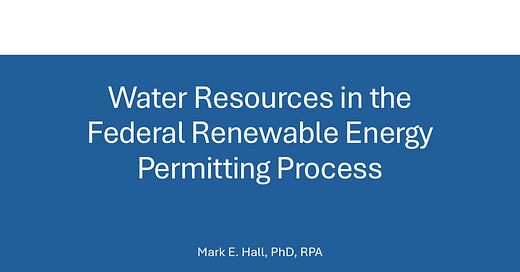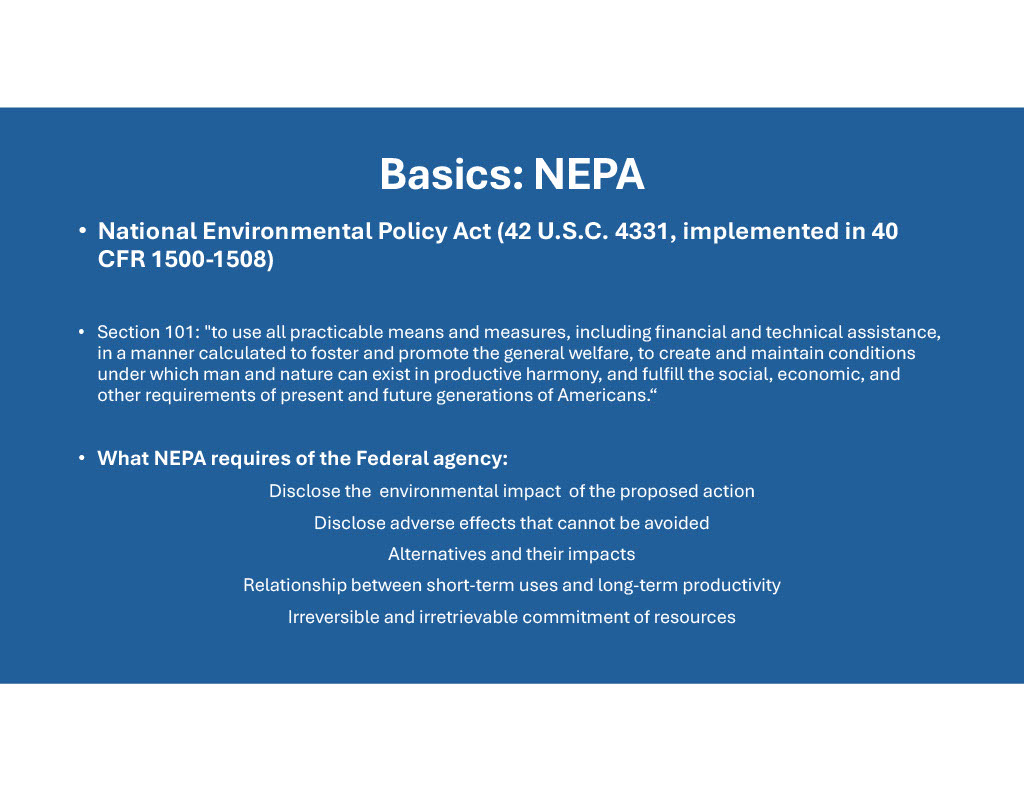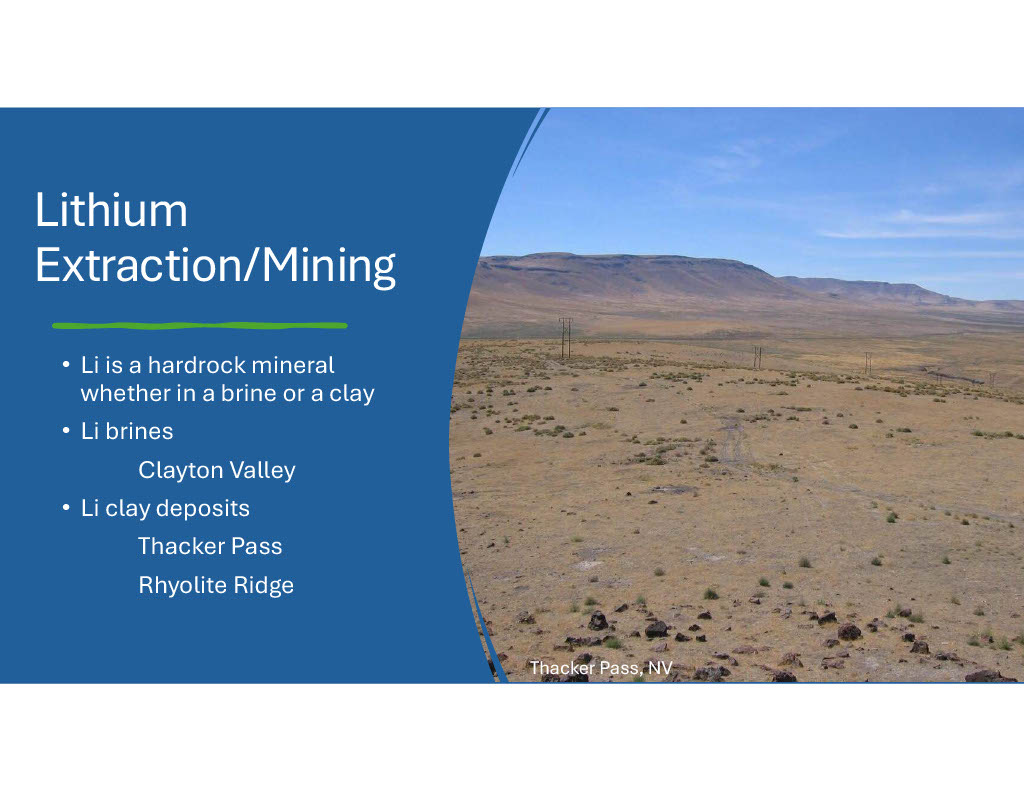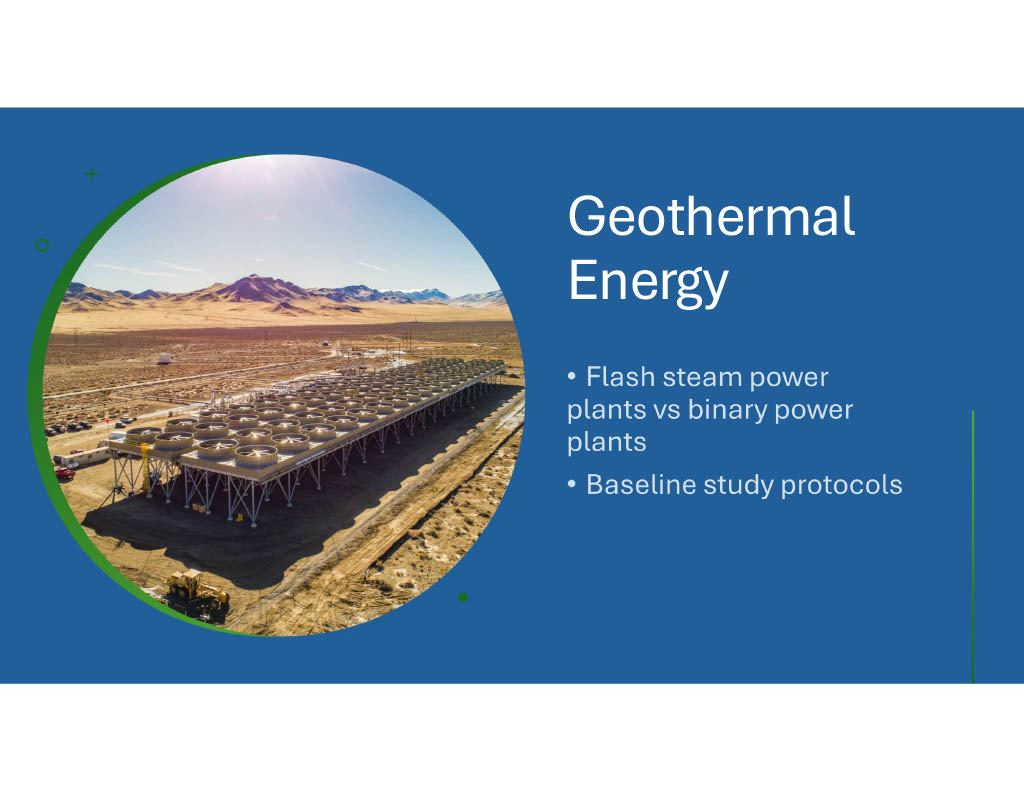Water Resources in the Federal Renewable Energy Permitting Process
A Presentation at the 2025 NWRA Annual Meeting in Reno
I was invited to give a presentation at this year’s Nevada Water Resources Association annual meeting in late January. The session I was in was entitled “Water and Sustainable Energy Development”. It was organized by Laurel Saito of the Nature Conservancy, and Matt Herrick of Broadbent and Associates was the moderator. It was a great panel touching on: 1) direct lithium extraction from brines; 2) an overview of geothermal development in Nevada; 3) publicly available resources for assessing potential geothermal impacts; 4) water resources in the federal permitting process (my paper); 5) renewable energy permitting at the local level; and 6) NV Energy’s water use and renewable energy projects. What made it particularly rewarding was the time between papers and at the end of the session to deal with questions and comments from a very engaged audience.
Well, on to my presentation….
_____________________________________________
Hi, Mark E. Hall, Sr. Environmental Planner with HDR
Before joining HDR, I was with the BLM. Served six years as the Field Manager for the Black Rock Field Office.
Today’s brief talk will do a quick overview of the National Environmental Policy Act, and then jump into a few aspects of water resources in the Federal permitting process with a focus on lithium mining and geothermal. Will touch on solar, but no discussion of wind energy (minimal wind energy generation in NV).1
National Environmental Policy Act (42 USC 4331, implemented in 40 CFR 1500-1508)
Note: Marin Audubon Society v. Federal Aviation Administration, No. 23-1067, D.C. Cir. Nov. 12, 2024, has ruled the White House Council of Environmental Quality has no authority to issue regulations. Still playing out in court. Recent Executive Orders are also calling into question some of 40 CFR 1500-1508.
GOAL of NEPA--Section 101 of National Environmental Policy Act: "to use all practicable means and measures, including financial and technical assistance, in a manner calculated to foster and promote the general welfare, to create and maintain conditions under which man and nature can exist in productive harmony, and fulfill the social, economic, and other requirements of present and future generations of Americans."
REQUIREMENTS OF NEPA:
Federal agencies need to prepare a detailed statement on: (1) the environmental impact of the proposed action; (2) any adverse effects that cannot be avoided; (3) alternatives to the proposed action; (4) the relationship between local short-term uses of man’s environment and the maintenance and enhancement of long-term productivity; and (5) any irreversible and irretrievable commitments of resources that would be involved in the proposed action. Note that this is in the law, and not the regulations!
NEPA documents are not meant to be encyclopedic, but concise.
In the latest regulations, NEPA documents should look at important issues that may rise to significance and unimportant issues should be eliminated from the analysis.
NEPA documents are not required to look at a worst-case scenario.
NEPA documents are to be written within a set time frame. For the Bureau of Land Management (BLM), Environmental Assessments (EA) need to be completed within in 1 year and Environmental Impact Statements (EIS) within 2 years. In the case of EAs, the starting point for the 1-year clock varies between BLM states—contrast NV BLM versus ID BLM.
NEPA is procedural. It does not dictate any particular or desired result. There seems to be an idea that the most environmentally friendly decision must be made, but that is not the case and has been held up repeatedly in federal court.
(Picture is of Thacker Pass from USGS files)
Li is not renewable energy per se, but it is crucial for development of solar and wind energy in regard to battery storage facilities.
Whether exploiting a brine or a clay lithium (Li) resource, Li is considered a hardrock mineral and subject to the regulations in 43 CFR 3809 and 43 CFR 3715.
In many parts of the world, lithium bearing brines are pumped to the surface, allowed to evaporate and the resulting salts are processed to produce lithium carbonate. Water is lost. Aquifers are not replenished, and adverse impacts to the aquifers would occur.
Trend to developing technologies that use a variety of methods to extract the Li from the brine and return the water to its parent aquifer.
Even with these newer technologies, under the Supplemental Authorities of NEPA, surface and groundwater are still present and still affected, so a baseline study and analysis are still required. The level of effort needed for a baseline for a project like this can be illustrated in the NEPA document for Schlumberger’s Clayton Valley Lithium Pilot Plant. Baseline studies included multi-year climate data, identification of surface water sources and wetland areas, flow rates for seeps and springs, a water well inventory with information on the depth to water, and surface and ground water quality studies.
Li deposits in clays are mined in open pit mines. Compared to gold and silver deposits, Li deposits are relatively shallow Despite the shallow depths, mines like Rhyolite Ridge and Thacker Pass go below the water table and require pumping for mining to occur. These mines will also have waste rock dumps. These mines and others will need a variety of quantitative and qualitative hydrological and geochemical studies to ascertain potential impacts. For BLM NV, policies for what studies need to be conducted are in place. Also the policies specify how the studies are to be done.
Some of the impacts from mining below the water table are: 1) draw down of the water table; 2) the potential of forming a pit lake after mining ceases; and 3) the potential to reduce base flows from springs and perennial water systems.
It also bears noting that one way to process Li bearing clays is by using sulfuric acid. The sulfuric acid can either be brought in by a tanker, or sulfur can be brought in and converted to sulfuric acid. If made on site, more water will be needed to make up the sulfuric acid.
(San Emidio geothermal power plant under construction, photo courtesy of Ormat LLC.)
One of the most common forms of renewable energy in central and northern NV.
Geothermal power plants produce electricity by two different systems—flash and binary. Flash steam plants use geothermal fluids over 360F to create steam which drives turbines to create electricity. Some of the steam is re-condensed and re-injected, but some of the steam (and thus water) is lost. In binary systems, hot geothermal fluids are brought to the surface and run through a radiator system to heat organic fluids which vaporize to turn a turbine. The geothermal water is directly re-injected into the aquifer.
Ideally, binary geothermal plants are a closed-loop, and in theory no water is lost during the operation of the plant. The geothermal industry generally asserts that water loses are minimal for a binary geothermal plant.
Water resources are a major concern with the public in the scoping and comment periods during the NEPA process for geothermal exploration and development projects. Drawdown of the ground water and the depletion of surface water sources are common public concerns. A variety of public interests are aware of the cases of: 1) Brady hot springs; 2) the spring in the Jersey valley; and 3) the springs in the Pumpernickel valley. In these three cases, geothermal exploration and development coincided with the depletion and drying up of surface water resources. (NOTE: emphasis on the word coincided, it doesn’t equate to causation.)
Water resource baseline studies are a key element in the permitting of geothermal exploration and development projects. The qualitative and quantitative data that is collected varies not only between projects given their potential intensity of impacts, but also can vary from BLM office to BLM office.
BLM NV is preparing a white paper/policy document for the hydrological baseline studies that will be required for geothermal exploration and development. The hydrological baselines were previewed at the 2024 Geological Society of America meeting. The objective of the studies is to define water resources within the geothermal project area and aid in the development of a water resources monitoring plan to be implemented during authorized operations.
Going to touch briefly on solar photovoltaic arrays and their associated battery energy storage systems.
As can be expected, during construction of these facilities, water would be used for dust suppression. But there are two areas of water use that can require analysis in a NEPA document:
Drainage/run-off. Depending on how the photovoltaic field ground surface is prepared—nearly complete vegetation removal or a minimal grading strategy. The vegetation removal and grading can impact storm water flow across the project area. An example where this was an issue was in the Gemini Solar EIS.
BESS cooling. Can be done one of two ways—using forced air or using radiator type system using water. Forced air cooling is inexpensive but not as efficient when it comes to cooling. Water cooling is efficient, but may result in water loss.
In summary, while the state or the US Army Corps may have jurisdiction over a water related resource, the NEPA process requires the lead Federal agency to analyze the impacts of the proposed project on those resources. This talk highlights some of the issues that can occur in renewable energy related projects.
Successful mitigation of any impacts requires coordination between the federal agency and the state.
Thank you for your time.
This talk was given on January 29, 2025. It is based on the law, regulations, policy, management and guidance in December 2024. This talk ha not been revised in light of the various Executive Orders issued since January 20, 2025.







